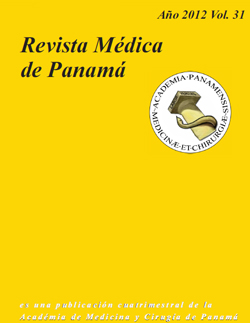ENFERMEDAD DE WILSON: DESCRIPCIÓN DE DOS CASOS EN GEMELOS IDÉNTICOS EN PANAMÁ.
Autores/as
DOI:
https://doi.org/10.37980/im.journal.rmdp.2012108Resumen
Se presentan dos casos clínicos de enfermedad de Wilson (degeneración hepatolenticular) en gemelos idénticos. Varones de 28 años de edad que inician síntomas psiquiátricos caracterizados por: trastornos del sueño, alteraciones de la personalidad, irritabilidad y labilidad emocional. Seguidamente, con sintomatología neurológica caracterizada por: voz disfónica, temblores asimétricos posturales y de acción, distonía de las manos, marcha atáxica de base ancha con componente festinante, ataxia truncal importante, leve disfagia y akinesia. La evaluación oftalmológica demostró la presencia del anillo de Kayser-Fleischer en ambos pacientes. Se comprobó alteración del metabolismo del cobre que consistió en aumento de su excreción urinaria en 24 horas (Normal=2-30 µg/dl) [136 (SCG), 267(ACG)], niveles de cobre sérico disminuidos (Normal=470-1360 µg/dl) [240(SCG), 206(ACG)] y reducción de la ceruloplasmina sérica (Normal=18-36 mg/dl) [4(SCG), 3(ACG)]. La resonancia magnética cerebral en ambos pacientes reveló intensidades anormales simétricas de los ganglios basales bilateralmente (núcleos lenticulares). La biopsia hepática de ambos casos reveló esteatosis, proceso inflamatorio y fibrosis leve a moderada sin demostrar cambios cirróticos. Este es el primer reporte documentado de enfermedad de Wilson en Panamá. Es posible que existan más casos en el país, ameritando un llamado de atención para su detección temprana y tratamiento oportuno lo que permitiría mejorar el pronóstico y la calidad de vida de estos pacientes. Estudios epidemiológicos y genéticos son necesarios para identificar la magnitud del problema en las comunidades en riesgo a fin de orientar las estrategias adecuadas para la prevención y control de esta enfermedad.
Colaboración de la Academia Panameña de Medicina y Cirugía e Infomedic International S,A. 2006-2013. Derechos reservados. www.revistasmedicas.org
Wilson disease description of two cases in identical twins in Panama.
Summary
Two cases of Wilson's disease (hepatolenticular degeneration) in identical twins are presented. Males 28 years of age who start characterized by psychiatric symptoms: sleep disturbances, personality changes, irritability and emotional lability. Then, with neurological symptoms characterized by: dysphonic voice, asymmetric postural and action tremor, dystonia of the hands, wide-based ataxic gait with propulsive component, important truncal ataxia, mild dysphagia and akinesia. The ophthalmologic evaluation showed the presence of Kayser-Fleischer ring in both patients. Alteration of copper metabolism that consisted of increased excretion in the urine within 24 hours (Normal = 2-30 g / dl) [136 (SCG), 267 (ACG)], decreased serum copper levels (Normal = 470- was found 1360 mg / dl) [240 (SCG), 206 (ACG)] and reduction of serum ceruloplasmin (Normal = 18-36 mg / dl) [4 (SCG), 3 (ACG)]. MRI brain in both patients revealed abnormal symmetrical intensities of the basal ganglia bilaterally (lenticular nuclei). Liver biopsy revealed steatosis both cases, the inflammatory process and mild to moderate fibrosis without showing cirrhotic changes. This is the first documented report of Wilson's disease in Panama. There may be more cases in the country, meriting a call of attention to early detection and timely treatment which would improve the prognosis and quality of life of these patients. Epidemiological and genetic studies are needed to identify the magnitude of the problem in communities at risk in order to guide appropriate for the prevention and control of this disease strategies.
Key Word: Copper metabolism, hepatolenticular degeneration, sleep disorder.
Descargas
Publicado
Número
Sección
Licencia
Derechos autoriales y de reproducibilidad. La Revista Médica de Panama es un ente académico, sin fines de lucro, que forma parte de la Academia Panameña de Medicina y Cirugía. Sus publicaciones son de tipo acceso gratuito de su contenido para uso individual y académico, sin restricción. Los derechos autoriales de cada artículo son retenidos por sus autores. Al Publicar en la Revista, el autor otorga Licencia permanente, exclusiva, e irrevocable a la Sociedad para la edición del manuscrito, y otorga a la empresa editorial, Infomedic International Licencia de uso de distribución, indexación y comercial exclusiva, permanente e irrevocable de su contenido y para la generación de productos y servicios derivados del mismo. En caso que el autor obtenga la licencia CC BY, el artículo y sus derivados son de libre acceso y distribución.






